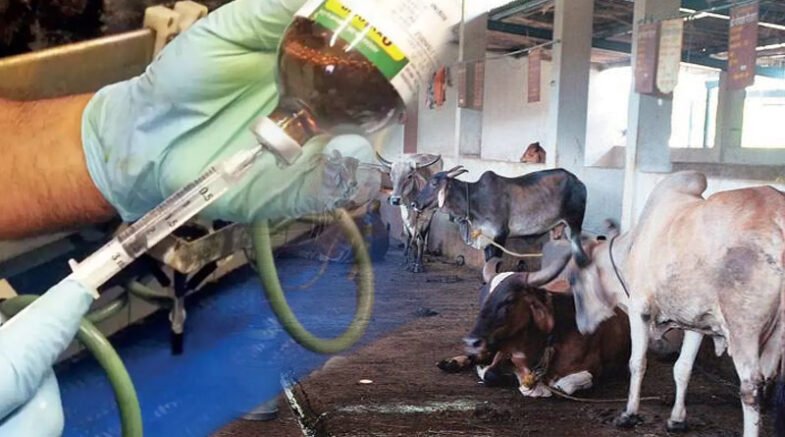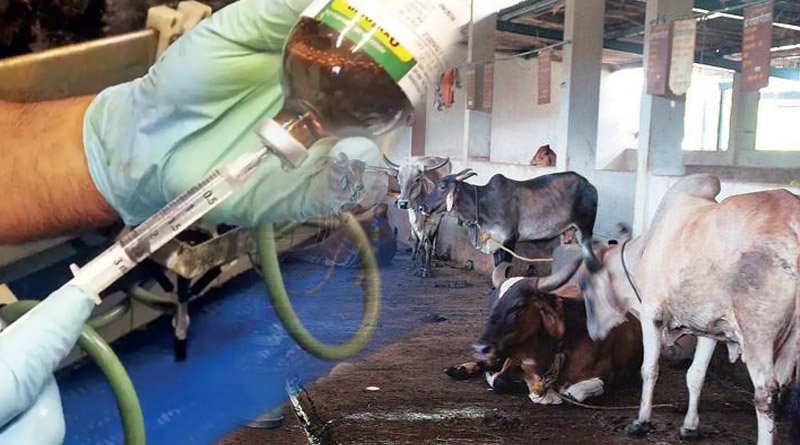A disadvantage of oxytocin injection was that its continuous usage could lead to addiction and lack of response to normal milk ejection stimuli, Srivastava said.

Ramadan is approaching, and the milkman will supply you with milk that has been obtained from cow or buffalo that was injected with Oxytocin injection to induce milking, but this could be harmful.
Oxytocin is a hormone released by the pituitary gland that causes increased contraction of the uterus during labor and stimulates the ejection of milk into the ducts of the breasts. This way, the hormone is the friend of both mother and baby.
Surprisingly, this hormone has been associated with many reactions. Oxytocin, dopamine, and serotonin are often referred to as our “happy hormones.” When you’re attracted to another person, your brain releases dopamine, your serotonin levels increase, and oxytocin is produced. This causes you to feel a surge of positive emotion.
When a baby latches on to breastfeed, and their mouth touches the nipples, the nerve cells in your breasts send a signal to the brain to release oxytocin. The oxytocin causes the muscles around the milk- making glands in your breast to contract.
When the glands contract, they squeeze the breast milk into the milk ducts. The milk ducts also contract to push the breast milk through your breast, and out of the nipple to your baby. This release of breast milk is called the let-down reflex.2 As your baby continues to breastfeed, more oxytocin is released, and breast milk continues to flow out of your breasts and to your baby.
Farming communities exploit this hormone and induce milking as per their desire. Also known as the “cuddle hormone”, this hormone is widely misused in the dairy industry to make livestock release milk at a time convenient to farmers. Hence there has been increased use of hormones, without realizing the negative effects on human health.
Oxytocin may cause jaundice and eye problems such as retinal haemorrhage in some new-born infants. If you have concerns about this, ask your doctor. This medicine may cause a serious condition called water intoxication.
In addition, oxytocin is intricately involved in a broad array of neuropsychiatric functions and may be a common factor important in multiple psychiatric disorders such as autism, schizophrenia, mood, and anxiety disorders.
A disadvantage of oxytocin injection was that its continuous usage could lead to addiction and lack of response to normal milk ejection stimuli, Srivastava said. He further said, “If the animals are milked under a stress-free environment and given proper milk ejection stimulus, there is no need to give oxytocin.
Milk adulterated with oxytocin should be avoided by pregnant women as it may lead to abortion and babies may be born with deformities. It increases the risk of haemorrhage in mothers after birth and can also inhibit breastfeeding. It has been concluded that boiling milk can help eliminate traces of oxytocin.
There is a big worry when you look at the list of side effects of indiscriminate use of oxytocin. Some side effects that have been reported are Confusion, convulsions (seizures), difficulty in breathing, fast or irregular heartbeat, headache (continuing or severe), hives, pelvic or abdominal pain (severe), skin rash, or itching,
Oxytocin injection may cause serious or life-threatening side effects in the new-born baby, including:
- slow heartbeats or another abnormal heart rate.
- jaundice (a yellow appearance of the baby’s skin).
- a seizure.
- eye problems; or
- problems with breathing, muscle tone, and other signs of health problems.
This is not a complete list of side effects and others may occur. It is therefore necessary to avoid drinking milk that has been obtained from a dairy animal injected with oxytocin for milking.
